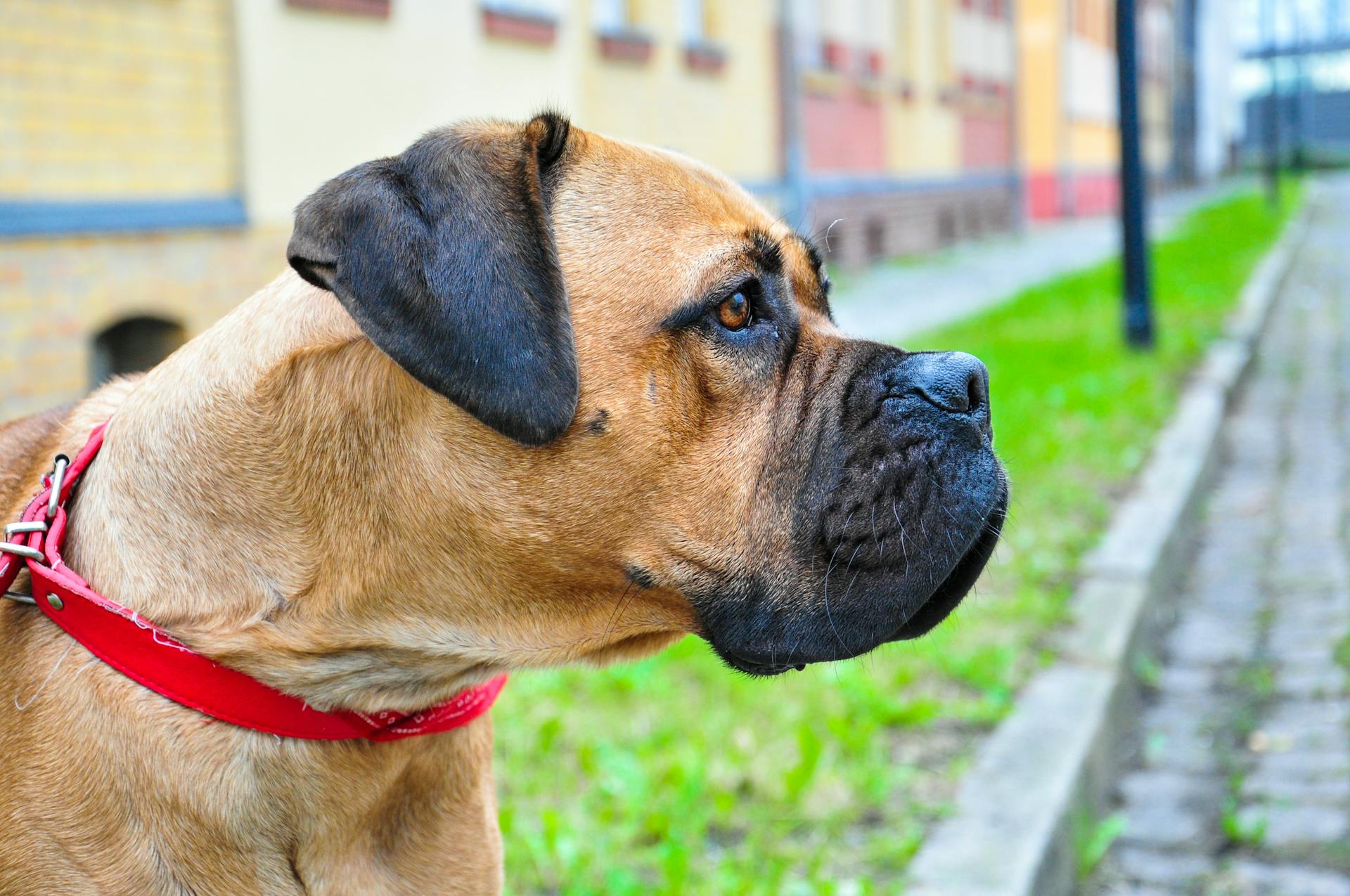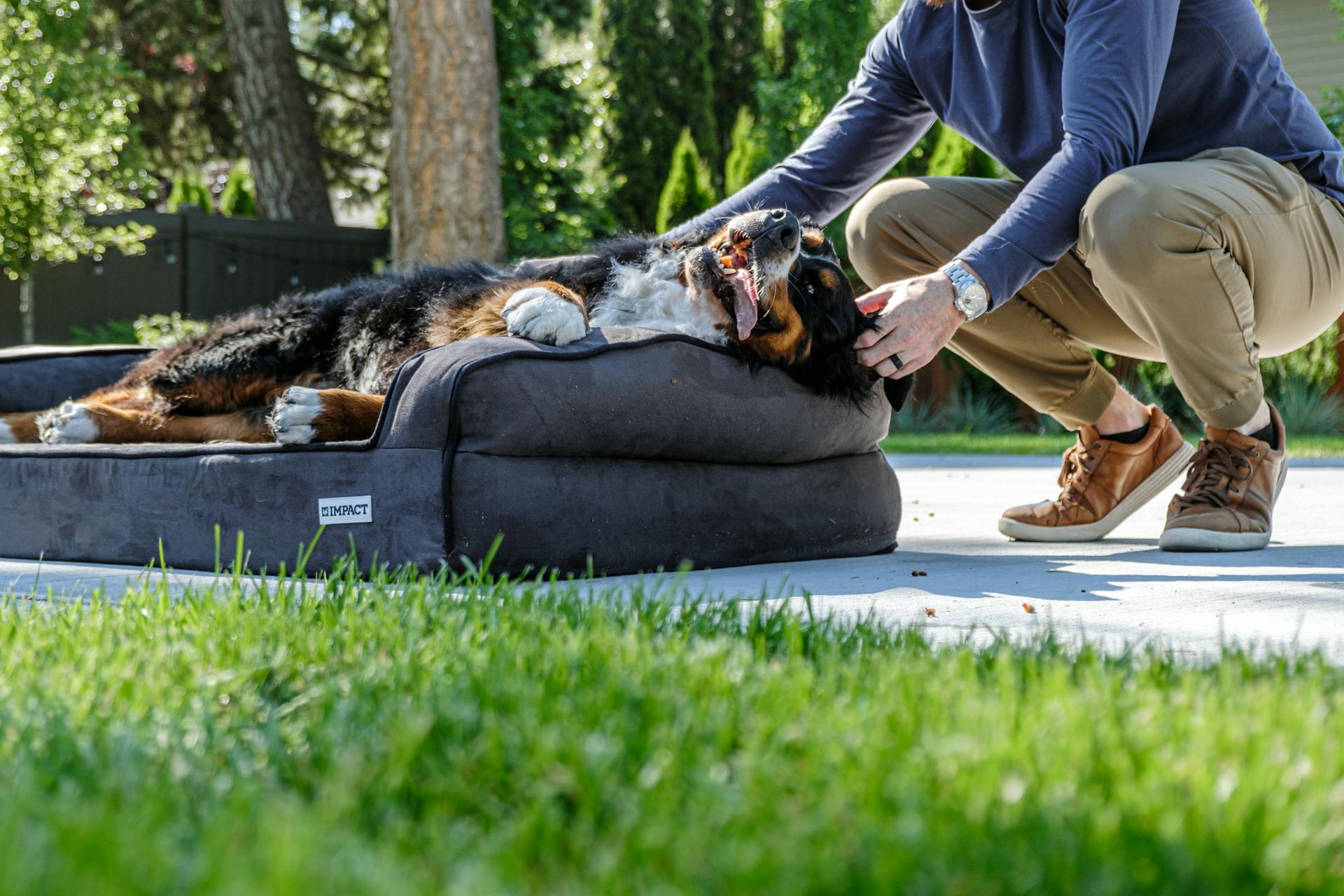
The majestic Bullmastiff - a gentle giant with a heart of gold. They are one of the largest dog breeds around.
Bullmastiffs typically weigh between 100 and 130 pounds (45 to 59 kg). Their massive size is due to their short, muscular legs that can cover ground quickly despite their weight.
These dogs have a broad chest and strong back that allows them to support their heavy frame. They also have a distinctive wrinkled face with a short muzzle and small ears that add to their unique appearance.
Despite their intimidating size, Bullmastiffs are known for being calm and gentle companions.
Appearance
The Bullmastiff is a large dog breed, with bitches standing between 61-66 cm tall at the withers and weighing around 41-50 kg.
Their coat is relatively low-maintenance, requiring only monthly brushing to reduce shedding. This makes them a great choice for busy owners who don't have time for frequent grooming sessions.
Bullmastiffs come in a variety of colors, including red, fawn, and brindle (a subtle tiger stripe). Some may also have a small white spot on their chest.
Their ears are V-shaped and floppy, held close to the cheeks. Their eyes are dark and medium-sized, giving them a gentle expression.
Here are some key features of the Bullmastiff's appearance:
- Ears: V-shaped, floppy, and held close to the cheeks.
- Coat Color: Red, fawn, or brindle (with small white spot on chest)
- Nose: Squished and black with large nostrils
- Tail: Long and may be straight or curved
Their muzzle is short and black, becoming paler towards the eyes. This doesn't affect their breathing, so you don't need to worry about them struggling for air.
Personality and Temperament
Bullmastiffs are affectionate dogs who form deep bonds with their humans and are faithful companions.
They're not much of a barker, as they were bred to be silent while tracking and pinning down poachers. This big softie will often lean against your leg or try to fold themselves into your lap - wherever you are is their favorite place to be!
Bullmastiffs can become suspicious of new people in their home, which is why socialization during puppyhood is critical. They'll be wary of strangers and may require early training to help them get used to having visitors.
This breed has lots of energy and requires training from an early age - they're very smart and learn quickly, so they do well in socialization classes, puppy training classes, and obedience training.
Dog Care
Bullmastiffs are fairly easy to care for.
They have a close-fitting short coat which sheds some year round. Regular brushing can keep their coat healthy and shiny (and keep shedding at bay).
You don't need to spend hours exercising your Bullmastiff, but training is crucial to keeping them well-behaved. A daily walk and playtime in a fenced-in yard should suffice.
Bullmastiffs are docile and affectionate with family members, but they become fearless guardians when their family is in danger. They're good with young children and other dogs, though all interactions between kids and pets should be supervised.
Establishing a regular veterinary care routine can significantly contribute to a longer, healthier life for your Bullmastiff. Routine check-ups allow for early detection and management of health issues common to the breed.
To train your Bullmastiff puppy effectively:
- Respond to specific commands like "sit" and "stay"
- Walk well on a leash
- Remain calm around other dogs, adults, and children
Health and Longevity
Bullmastiffs generally live between 8 to 10 years.
Monitoring your Bullmastiff for signs of joint problems involves being vigilant about changes in their mobility, behaviour, and overall comfort levels. Early signs may include reluctance to climb stairs, jump, or play; limping or stiffness, especially after resting; noticeable discomfort during or after exercise; and swelling or tenderness around the joints.
Implementing a routine of gentle, regular exercise, maintaining a healthy weight, and providing joint supplements as recommended by a veterinarian can support joint health. Regularly feeling the joints for signs of swelling or heat can help detect problems early.
Readers also liked: How to Treat English Bulldog Skin Problems
Skin and Coat

Bullmastiffs have a short coat that sheds some year round.
Regular brushing is essential for keeping their coat healthy and shiny, as well as reducing shedding. This simple habit can go a long way in maintaining your Bullmastiff's overall health.
Their close-fitting short coat isn't prone to matting, so you won't need to worry about professional grooming sessions.
Lifespan Expectancy
The average lifespan of a Bullmastiff is typically between 8 to 10 years.
This range can vary based on several factors, including genetics and the level of care they receive. Providing a loving environment, along with attention to their health, nutrition, and exercise needs, can help maximize their years of companionship.
Bullmastiffs are considered a giant breed, and like many large dogs, they tend to have shorter lifespans compared to smaller breeds. Ensuring they live in a loving, stress-free environment also contributes significantly to their overall well-being and longevity.
Some Bullmastiffs can live beyond their average expectancy with proper care, including a balanced diet, regular exercise, and routine veterinary check-ups.
For another approach, see: English Bulldog 1900 vs Now
Joint
Joint health is a vital aspect of your Bullmastiff's overall well-being. Regular exercise and maintaining a healthy weight can support joint health.
As your Bullmastiff ages, you may notice changes in their mobility and behaviour that could indicate joint problems. Early signs include reluctance to climb stairs or jump, limping or stiffness after resting, noticeable discomfort during or after exercise, swelling or tenderness around the joints, increased irritability, or a decrease in activity levels.
Regularly feeling your Bullmastiff's joints for signs of swelling or heat can help detect problems early. A thorough examination by your veterinarian may include x-rays or other diagnostic tests to assess the condition and determine the best course of treatment.
Hip dysplasia is a common genetic condition that affects large breeds like Bullmastiffs, leading to arthritis or mobility problems. Management may include weight control, supplements, or surgery in severe cases.
Some signs of hip dysplasia in your Bullmastiff may include lameness, slowness to rise from a lying position, a "bunny-hopping" gait when running, reluctance to run, jump, or go up or down stairs, and holding the affected leg out to the side when sitting up.
Worth a look: Hip Dysplasia Bernese Mountain Dog
A PennHIP evaluation allows for early detection and treatment of hip dysplasia. Reputable breeders will ensure that their Bullmastiffs have PennHIP evaluations as part of their health screening.
Managing Joint Problems in Your Bullmastiff
- Regular exercise, maintaining a healthy weight, and providing joint supplements as recommended by your veterinarian can support joint health.
- Weight control, supplements, or surgery may be necessary to manage hip dysplasia.
- Consult your veterinarian for a thorough examination if you suspect your Bullmastiff is developing joint problems.
Retinal Degeneration
Retinal Degeneration is a serious condition that affects some breeds of dogs.
Progressive Retinal Atrophy (PRA) can occur due to various genetic mutations and causes the retina to slowly degenerate, eventually leading to blindness. This condition usually develops in young to middle-aged Bullmastiffs. Gene therapy may help dogs with PRA, but more research is needed to improve the outcome.
Dogs that carry genetic mutations for PRA should not be bred, as reputable breeders will have their dogs' DNA tested to identify these mutations.
Preventive Measures
Preventive Measures can make a significant impact on your Bullmastiff's longevity. Implementing preventive health measures is essential to protect against diseases and infections.
Maintaining a routine of vaccinations and parasite control is crucial for this purpose. Feeding smaller, more frequent meals and avoiding vigorous exercise around feeding times can also help prevent bloat, a serious condition that Bullmastiffs are prone to.
Regular veterinary check-ups are vital for early detection and management of health issues such as hip dysplasia, heart problems, and hypothyroidism.
Preventing Obesity

Feeding your Bullmastiff a high-quality diet that's appropriate for their age, size, and energy level is essential to prevent obesity.
You should avoid overfeeding and give treats sparingly, accounting for them in your dog's daily calorie intake. Regular veterinary check-ups can help monitor your weight and adjust your diet as needed.
Establishing a consistent exercise routine that includes daily walks and playtime is also crucial to keep your Bullmastiff active. Choose low-impact exercises like walking or swimming to avoid putting excessive strain on their joints.
Maintaining a healthy weight through proper nutrition and regular exercise can significantly reduce the risk of common health problems in Bullmastiffs.
Environmental Factors and Dogs
Environmental Factors and Dogs are a crucial aspect of your furry friend's overall health.
Exposure to extreme temperatures can be hazardous for dogs like Bullmastiffs due to their large size and susceptibility to overheating. Ensure they have a cool, shaded place during hot weather and avoid strenuous exercise in high temperatures.
Providing a clean, stress-free living environment is vital in reducing the risk of anxiety-related behaviors and contributing to overall well-being. Tailoring the environment to meet your dog's specific needs can play a significant role in maintaining their health and extending their lifespan.
Minimizing exposure to chemicals indoors and outdoors is essential in preventing skin irritations and allergies. Indoor environments should be safe and free from hazards that could cause injury, such as slippery floors that can increase the risk of joint injuries.
Creating a calm, stable environment at home is crucial in supporting your dog's emotional health. Ensuring they feel secure and loved with plenty of attention and affection can significantly contribute to their mental well-being.
Broaden your view: German Shorthaired Pointer Free to Good Home
Training and Socialization
Training and socialization are essential for Bullmastiffs. They're intelligent and quick learners, picking up basic commands like sit, stay, and come right away.
Firm, consistent training is necessary to prevent mishaps when they grow older. You want to teach your puppy not to pull on the leash or jump on people during training to avoid accidents later on.
Early socialization exposes them to various people, animals, and situations, promoting confidence and reducing stress and anxiety. A well-socialized Bullmastiff is more likely to lead a balanced life and contribute positively to their health and longevity.
Socialization and Training
Socialization and Training are crucial for Bullmastiffs from a young age. This exposes them to various people, animals, and situations, promoting confidence and reducing stress and anxiety.
To socialize your Bullmastiff effectively, start early and be consistent. You want to help them become confident in new environments and situations. A well-socialized Bullmastiff is more likely to lead a balanced, stress-free life, contributing positively to their health and longevity.
Proper training and socialization are important for the Bullmastiff breed. They're smart but also have an independent streak, so training will require firm consistency. Curb any habit of jumping on people early on, as this can lead to a hazardous situation once the dog is fully grown.
Bullmastiffs need experienced pet parents willing to dedicate time to socialization and training. These powerful dogs may not always know their strength, so it's essential to teach them basic commands like sit, stay, and come right away. They're intelligent and quick learners, but also strong, so be sure to teach your puppy not to pull on the leash or jump on people during training.
To keep your Bullmastiff from bounding towards guests who enter your home, teach them the "place" command. This is where you encourage them to go sit in a certain spot every time, like their crate or bed. You can hold a treat over it, say "place", then give them the treat and praise when they sit in the spot.
A well-socialized and trained Bullmastiff contributes positively to their health and longevity. They're more likely to lead a balanced, stress-free life if you invest time in socialization and training from an early age.
Broaden your view: When Is Best Time to Breed Dog
Common Challenges
As you delve into training and socialization with your Bullmastiff, it's essential to acknowledge the potential common challenges that come with owning this breed.
Bullmastiffs are prone to several health issues that can impact their quality of life if left unaddressed.
Regular check-ups with a veterinarian are crucial for monitoring and maintaining your Bullmastiff's health, allowing you to take proactive steps in managing any conditions early on.
Exercise is vital for Bullmastiffs, but it should be moderated to avoid putting excessive strain on their joints.
Preventing Common Issues in Your Dog
A high-quality diet is essential for your Bullmastiff's health and well-being, focusing on foods that support joint health and maintain a healthy weight.
Regular veterinary check-ups are crucial for early detection and management of health issues such as hip dysplasia, heart problems, and hypothyroidism.
Feeding your Bullmastiff smaller, more frequent meals can help prevent bloat, a serious condition they're prone to.
Implementing a proactive healthcare routine, including dental care and skin maintenance, can significantly reduce the risk of common health problems.
Low-impact activities like walking and swimming are excellent exercise choices for Bullmastiffs, as excessive strain on their joints should be avoided.
Regular brushing is necessary to keep your Bullmastiff's close-fitting short coat healthy and shiny.
Expand your knowledge: Healthy Bull Terrier
Bullmastiff History and Overview
The Bullmastiff breed was developed in England during the mid-1800s.
Gamekeepers needed a dog to protect their game from poachers, so they experimented with cross-breeding bulldogs and mastiffs. The resulting Bullmastiff was the ideal guard dog, with its calm yet formidable nature and brindle color providing natural camouflage at night.
The Bullmastiff was recognized as a breed by the American Kennel Club in 1933, after being used to guard the De Beers diamond mines in South Africa around the late 1920s.
Breed History
The Bullmastiff breed was developed in England during the mid-1800s.
Gamekeepers needed a dog to protect their game from poachers, so they experimented with cross-breeding bulldogs and mastiffs, resulting in the ideal guard dog. This breed was preferred for its strength, size, and speed, making it perfect for catching poachers at night.
The brindle color of the Bullmastiff provided natural camouflage, allowing them to sneak up on poachers undetected. In fact, gamekeepers often preferred brindle dogs for this very reason.
By the early 20th century, the Bullmastiff was in widespread use as an aid to gamekeepers in controlling poaching. They were bred specifically for their strength and size, making them a formidable guard dog.
The Bullmastiff was recognized as a breed by The Kennel Club in 1924, with strict guidelines that included a minimum of four generations of descent from Bullmastiff stock without input from either Bulldog or Mastiff. This ensured the purity of the breed and its unique characteristics.
In 1933, the American Kennel Club (AKC) also recognized the Bullmastiff as an official breed.
Additional reading: American Kennel Club Lancashire Heeler
Breed Overview
The Bullmastiff breed is truly a unique and wonderful companion dog. They stand between 24 to 27 inches tall.
Their weight range is significant, falling between 100 to 130 pounds. This sturdy build can be intimidating, but it's also a testament to their strength and resilience. Their short, dense coat requires minimal grooming and sheds relatively little.
You'll often find Bullmastiffs in fawn, red, or brindle colors with accents of black, which adds to their rugged charm. As for lifespan, these lovable dogs typically live between 8 to 10 years.
Frequently Asked Questions
Is a Bullmastiff a good family dog?
Yes, Bullmastiffs can be excellent family dogs for households with older children. However, they require regular exercise and mental stimulation to thrive.
What are the weaknesses of a Bullmastiff?
Despite being a generally healthy breed, Bullmastiffs are prone to hip dysplasia, eyelid problems, cancer, mast-cell tumours, and various cardiac diseases
Are Bullmastiffs aggressive?
Bullmastiffs are generally mild-mannered but may become aggressive with other males or strangers. However, they are often gentle and loving towards their owners and young children.
Why do Bullmastiffs not bark?
Bullmastiffs were bred not to bark or bite intruders, but rather to track and apprehend them quietly. This unique trait was designed by wealthy landowners who wanted their dogs to catch thieves without scaring them away.
Why are Bullmastiffs so expensive?
Bullmastiffs are generally more expensive to own due to their high food consumption and larger size requirements. This includes higher costs for food, accessories, and potential healthcare expenses.
Featured Images: pexels.com